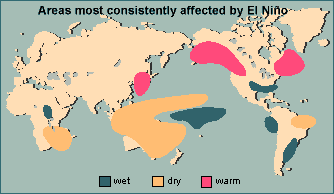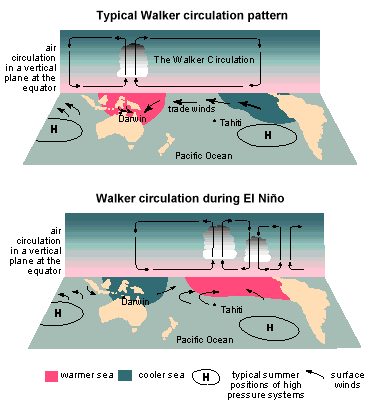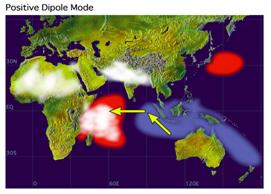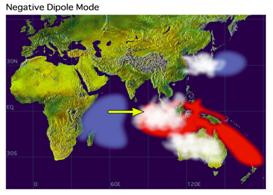What is climate (and weather)?
The (Australian) Bureau of Meteorology1 define climate as “the sum or synthesis of all the weather recorded over a long period of time. It tells us the average or most common conditions, or extremes, or counts of events, or frequencies”. Whereas they describe weather as “a description of conditions over a short period of time – a “snap shot” of the atmosphere at a particular time”. In simple terms, climate is what is generally most likely to occur (i.e. what you expect); weather is what you get.
Natural Climate Variability in Australia
There is a great deal of natural variability in the climatic zones across Australia. Some of this variability is obvious i.e. summer versus winter or the wet versus the dry. Other important – yet not so obvious – sources of natural climate variability in Australia are changes in circulation patterns associated with the El Niño Southern Oscillation (ENSO), the Inter-decadal Pacific Oscillation (IPO), the Indian Ocean Dipole (IOD) and the Antarctic Oscillation (AAO) or Southern Annular Mode (SAM). We provide brief descriptions of each of these changes below.
ENSO El Nino- Southern Oscillation
El Niño refers to the extensive warming of the sea surface region in the central and eastern Pacific that leads to a major shift in weather patterns across the Pacific. In Australia (particularly eastern Australia), El Niño events are associated with an increased probability of drier conditions (Fig. 1).


Figure 1. Typical impacts of El Nino events2.
The Southern Oscillation Index (SOI) is calculated from the monthly or seasonal fluctuations in the air pressure difference between Tahiti and Darwin.
Sustained negative values of the SOI often indicate El Niño episodes. These negative values are usually accompanied by sustained warming of the central and eastern tropical Pacific Ocean, a decrease in the strength of the Pacific Trade Winds, and a reduction in rainfall over eastern and northern Australia. The most recent strong El Niño was in 1997/98.
Positive values of the SOI are associated with stronger Pacific trade winds and warmer sea temperatures to the north of Australia, popularly known as a La Niña episode. Waters in the central and eastern tropical Pacific Ocean become cooler during this time, shifting convection associated with the Walker circulation over the Australian region (Fig. 2). Together these give an increased probability that eastern and northern Australia will be wetter than normal2.

Figure 2. A schematic of the typical circulation pattern and those associated with El Nino events2.
IPO (Interdecadal Pacific Oscillation)
The Interdecadal Pacific Oscillation (IPO) is similar to El Nino in that it is a change in climate related to sea surface temperatures (SST). However the IPO events tend to last much longer, 20-30 years as opposed to 18 months, and the changes manifest themselves mainly in the northern and southern Pacific with only secondary characteristic seen in the tropics, the opposite to ENSO3. What is unclear at this time is how, or if, and to what extent IPO is separate from ENSO. This is important as understanding IPO could lead to better long term projection of ENSO events that will directly affect Australian rainfall4.
IOD (Indian Ocean Dipole)
The Indian Ocean Dipole (IOD) is a climate mode that occurs in the tropical parts of the Indian Ocean. During a positive IOD event, the SST drops in the southeastern part of the Indian Ocean: off the northern coast of Australia, the eastern coast of Japan and throughout Indonesia; while the SST rises in the western equatorial Indian Ocean: off the eastern coast of Africa, from the northern half of Madagascar to the northern edge of Somalia. In a negative IOD event the reverse conditions exist, as illustrated below.



Figure 3. Positive and Negative Indian Ocean Dipole modes. Red indicates high sea surface temperatures light blue indicates lower sea surface temperatures. From the UN Atlas of the Oceans5.
AAO or SAM (Antarctic Oscillation or Southern Annular Mode)
The Antarctic Oscillation (AAO) or Southern Annular Mode (SAM) is a mode of variation in the atmosphere of the high latitudes in the southern hemisphere; there is a northern hemisphere equivalent, the Artic Oscillation. Some research has suggested that a strengthening of the Antarctic Vortex “pulls” the westerlies that bring rain to the southern part of the Australian continent closer towards the South Pole. This could reduce rainfall in Australia and may have contributed to the decline seen in south west WA over the past 30 years6.
What is Climate Change?
Climate change, as opposed to climate variability, is the term used to describe changes in average weather over time periods ranging from decades to millions of years. These changes may be driven by external forces (i.e. predictable orbital variations or solar variation), result from processes internal to the Earth (i.e. plate tectonics or volcanic activity) or be caused by human activities (anthropogenic) such as global warming.
An increase in greenhouse gas levels (global warming) is only one impact that humans have on climate. Recent research has suggested that the aerosols and particulate pollution from industry and vehicles has lead to a similar cooling effect that might be reversed as these processes are cleaned up78. The clouds, or condensation trails (contrails), produced by Aircraft are other impacts that is not well understood. Clouds are thought to produce a cooling effect by reflecting in coming radiation from the sun. However they also serve to prevent infrared radiation from leaving the atmosphere resulting in a heating affect. Which effect has the greater impact on average temperatures is dependent on the elevation of the cloud, its thickness and also its optical properties.
Considerations for measurement and interpretation of climate change
Detection
Detection is the process of determining whether or not a change in the climate is occurring, and how it is manifested (i.e. temperature change, rainfall change, etc.). In the case of climate change, changes most be shown to be statistically larger than what could be expected form natural variability (discussed below). As the frequency and severity of extreme weather events such as storms is extremely variable, it is very difficult to demonstrate whether or not they are changing.
The most statistically valid example of recent climate change in Australia is the stepwise decrease in rainfall observed in south west Western Australia. As discussed on the Global Warming page, total annual rainfall in Perth and its surrounds dropped dramatically in the mid 1970’s and has remained well below long term averages through to the present. This decrease in rainfall has led to a much larger decrease in the runoff into Perth’s water supply reservoirs and for environmental flows in rivers throughout south west WA.
Attribution
Attribution is the process of determining the causes of change. In the case of climate change, while we can determine the causes of increased CO2 levels and we can correlate the severity of storms with warmer sea surface temperatures, we can not attribute the occurrence of one severe storm to climate change.
Abrupt Changes
As shown in the global warming page, some changes can occur abruptly without warning. These changes are not slow gradual variations that can be monitored or predicted and therefore will not be accounted for through planning or mitigation. These sudden rapid transformations in conditions could devastate an ecosystem.
Significance of Climate Change
The global warming fact sheet discusses observed changes and potential impacts of climate change with emphasis on the coastal zone.
Existing information and Data
Long term Australian data on temperature, rainfall and sea surface temperatures are available from The Bureau of Meteorology. The BOM website allows users to create trend maps and time series graphs of various data for specific regions or for all of Australia.
The Department of Climate Change through the Australian Climate Change Science Program has produced a number of publications on the climate change science in Australia and the potential impacts of climate change on Australia. These include: Climate Change – An Australian Guide to the Science and Potential Impacts by Barrie Pittock, Climate Change 2009; faster change and more serious risks by Will Steffen and Climate Change in Australia technical report 2007
Key questions and further research needs
- Impact of climate change on major circulation patterns (ENSO, IPO, IOD and AO) and their significance on climate variability in Australia
- Impact of storm intensity and frequency on the built and natural environment within the coastal zone
- Likelihood and significance of abrupt climate change conditions
Authors
Geoscience Australia
Department of Climate Change
- Australia Bureau of Meteorology: Climate ↩
- Australia Bureau of Meteorology:Risk Management and El Niño and La Niña ↩ ↩ ↩
- Science – EL Nino/La Nino & PDO ↩
- Renwick J.A., Salinger M.J., Mullan A.B., Folland C.K. & Gosai A. (2002) Relative Influences of the Interdecadal Pacific Oscillation and ENSO on the South Pacific Convergence Zone Island, Climate Update 25 -October ↩
- In UN Atlas of the Oceans ↩
- Australian Climate Change Science Programme: Strategic Research Agenda 2004-2008 (2005) Ashley Fuller (ed). Australian Greenhouse Office, in the Department of the Environment and Heritage. ↩
- Bellouin, N., O. Boucher, J.Haywood and M. S. Reddy. (2005) Global estimate of aerosol direct radiative forcing from satellite measurements, Nature, 438, 1138-1141 ↩
- Yu, H., Y.J. Kaufman, M. Chin, G. Feingold, L.A. Remer, T.L. Anderson, Y. Balkanski, N. Bellouin, O. Boucher, S. Christopher, P. DeCola, R. Kahn, D. Koch, N. Loeb, M.S. Reddy, M. Schulz, T. Takemura, and M. Zhou (2006). A review of measurement-based assessment of aerosol direct radiative effect and forcing. Atmos. Chem. Phys. 6, 613-666 ↩


